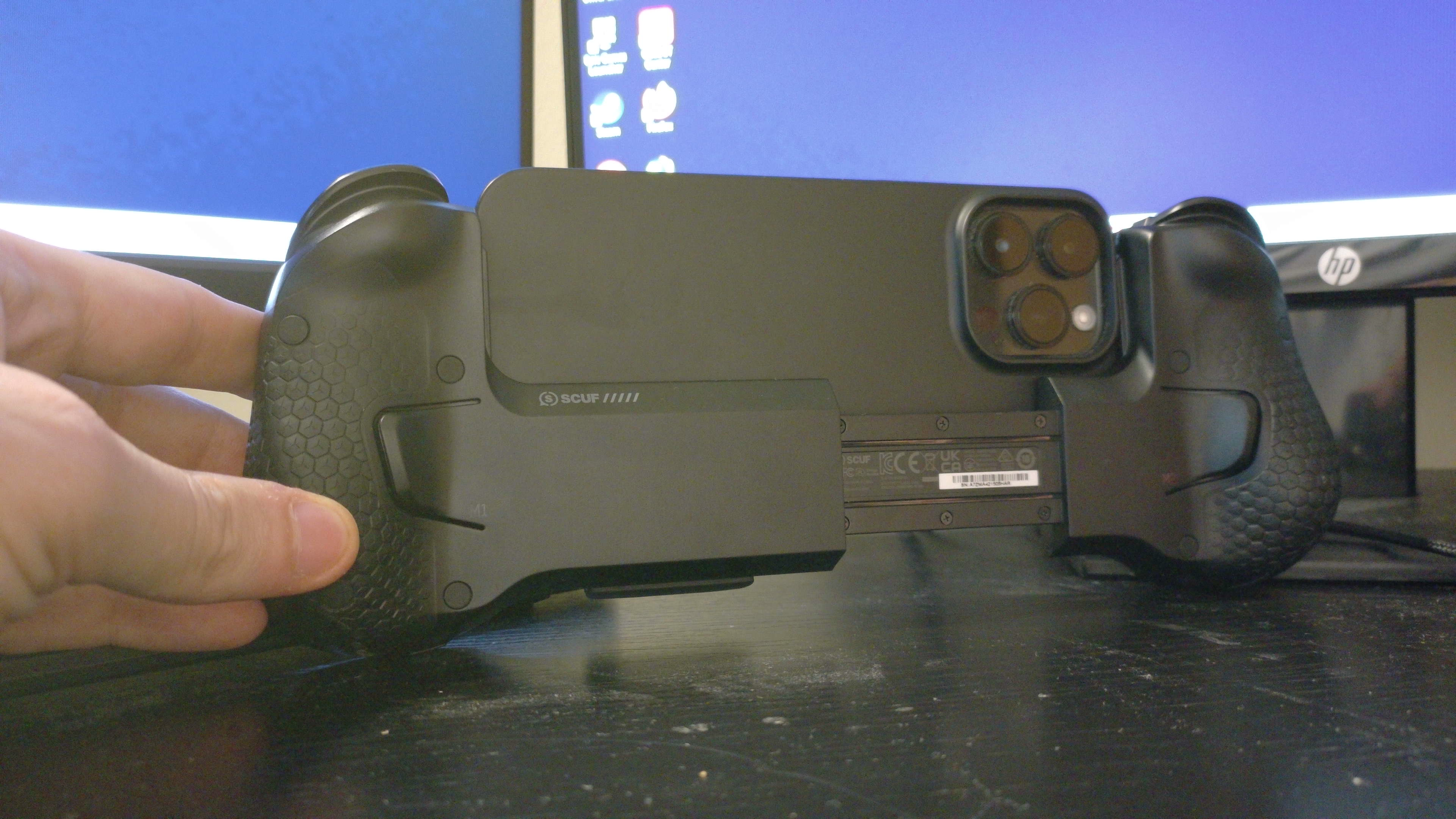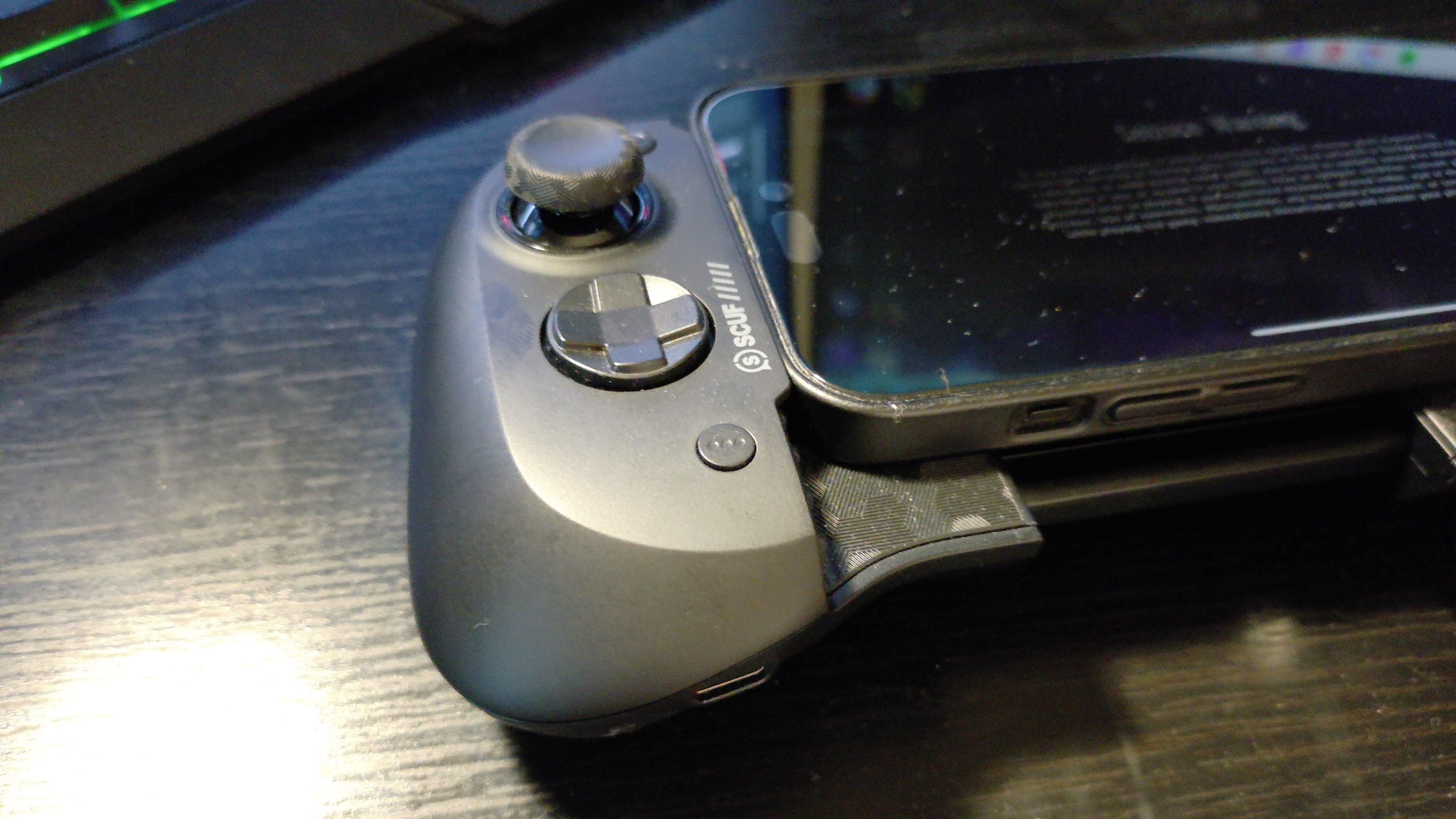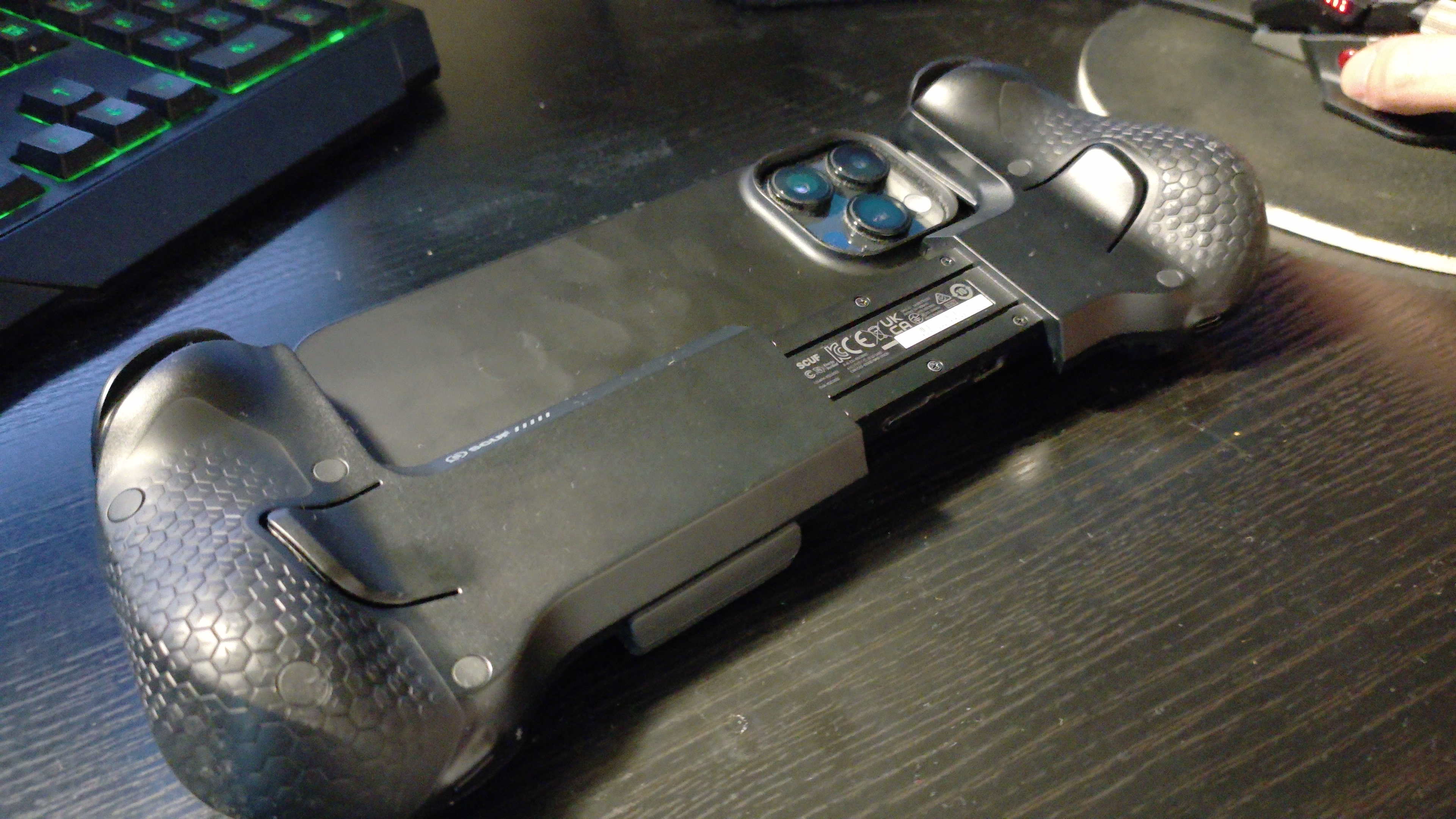GamesRadar+ Verdict
Scuf’s first attempt at a mobile controller with the Nomad has resulted in one of the most impressive and feature-rich controllers on the market for your on-the-go gaming. It’s an attempt that will have you leaving your Backbone at home.
Pros
- +
Fantastic performance
- +
Comfortable design
- +
Symmetrical thumbsticks
- +
Rear buttons
- +
Free app
- +
Compatibility with iPhone cases
Cons
- -
No support for Android
- -
Thumbsticks are a little loose
- -
Small face buttons
Why you can trust GamesRadar+
One of my favorite aspects of gaming in the modern age is portability. No longer are you stuck to just your living room or your desk to play your latest games, you can take them on the go and game wherever you like. As someone who frequently travels for work and personal reasons, I like to be able to continue my gaming sessions no matter where I am. And thanks to mobile controllers like the Scuf Nomad, I can do just that.
The Backbone controller was perhaps one of my favorite pieces of tech that I have purchased in the last few years, and I think a lot of people would agree with me as it’s considered one of the best mobile controllers for a reason. Having said that, I think most people would agree that it is starting to show its age these days, especially since so many competitors have now entered the scene to steal a share of its market.
One of those hungry rivals is the Scuf Nomad. A name you are no doubt familiar with, Scuf has finally entered the mobile controller landscape and has done so with both an impressive lineup of features and a competitive entry price, sitting at just $99/£89 - exactly the same price as the Backbone One.
Design

One of my biggest worries when using any mobile controller, Backbone included, is that my hand will cramp mid-playthrough because of the smaller form factor. We’ve all been there, almost securing that game-winning kill on Call of Duty Mobile and then your hand decides not to cooperate and send spasms shooting up your arm - no? Just me making excuses?
Thankfully, I’ve never experienced this with the Scuf Nomad. It feels much, much larger than both the Backbone One and the GameSir X4 Aileron - feeling more comparable to the GameSir G8 Galileo. The grips of the controller feel perfectly contoured to your hands, resting naturally in the palms without feeling intrusive, in large parts thanks to the thicker handles on the base of the device which allows more of a grip. I think this is accentuated by the fact that the thumbsticks on the Scuf Nomad are symmetrical, with their placement being at the top of the device rather than the usual asymmetrical layout you’d find on most mobile controllers.
Honestly, I can sum up the performance in a simple sentence: I have not once considered picking up the Backbone One since the Scuf Nomad arrived. It just outperforms it in every way.
Speaking of the thumbsticks, unlike the Backbone One you’ll find full-sized sticks on the Scuf Nomad. Not only that, they utilize hall-effect technology to counter long-term stick drift, which is always appreciated - this is something you’d really expect in the best PC controllers, so it’s a welcome bonus in a more portable option. The sticks have a concave design which makes it super comfortable for your thumbs to rest on them - this can be changed via alternative thumbstick caps which allow you to change to a convex design, similar to the PlayStation 3’s Dualshock 3. Grip-wise, I have nothing to complain about here. The material that the sticks are made from is almost rubber-like which sticks to your thumb nicely but never feels tacky, and I never found myself losing my grip throughout my extensive use of the Nomad.
At the rear of the controller, you’ll find two additional back buttons which are programmable via the Scuf Nomad mobile app. Alongside this, you have the standard shoulder buttons and triggers, along with the classic Xbox layout face buttons and a disc-shaped d-pad similar to the Xbox Series line of controllers.
Features

Scuf has specifically made this controller for the iPhone, which is surprising due to the fact that it connects exclusively via Bluetooth. You’ll find no physical connector on the Scuf Nomad aside from the USB-C port at the base of the controller which charges the device. This unfortunately means no pass-through charging, so make sure your iPhone is fully charged before those long gaming sessions.
Like most of the best mobile controllers, the Scuf Nomad has a classic spine that stretches to allow your phone to be placed in the middle and clamped into place. I was very impressed by the build quality of the Scuf Nomad. I always feel that the Backbone One is very flimsy and could break if stretched too far, which I never find with the Nomad.
The buttons have a nice feel to them when pressed and are super silent so you don’t have to worry about annoying whoever you are sitting next to on those long train journeys when your buttons keep clicking non-stop - again, just me?

Coming with every Scuf Nomad controller for free is the Scuf Nomad Mobile app. This doesn’t need a subscription and allows you to customize your Nomad in a variety of ways. This includes the dead zones on your thumbsticks and triggers and allows you to remap almost every button on the controller including the extra rear buttons. I really appreciate the fact that the app is free, this is a nice change of pace compared to the Backbone which requires you to pay to make the most of it. Similar to the Backbone app it acts as a hub to enter games and other apps such as PlayStation Remote Play and Apple Arcade.
One of the greatest features that I think will often get overlooked is the ability to use this controller without removing your ridiculously expensive iPhone from its protective case. This was a feature I didn’t know how much I actually needed or wanted. It saves mere seconds of time but it’s just so much nicer not to have to remove it every time I fancied jumping into Hades for five minutes on my lunch break.
Performance

Honestly, I can sum up the performance in a simple sentence: I have not once considered picking up the Backbone One since the Scuf Nomad arrived. It just outperforms it in every way. Not just the Backbone, but I found it even outperformed the Android-only GameSir X4 Aileron too, and I awarded that a commendable 4.5/5.
As I previously mentioned, the Nomad features full-sized thumbsticks in a symmetrical layout, more akin to the Steam Deck OLED, or the CRKD Nitro Deck+ than your usual mobile controller. This simple change made it a much more pleasurable experience which allowed me to use the controller for much longer gaming sessions, I can’t recall ever actually experiencing cramps during my time with the Scuf Nomad. However, admittedly, I would have liked a way to increase the tension of the thumbsticks. They are a little on the loose side for my liking and there is no way of changing this so I was forced to adapt. I managed to and I no longer feel like it’s an issue, but it’s worth noting - perhaps this will be remedied on Scuf’s next foray into the mobile market.
The face buttons sitting underneath the thumbstick took some getting used to, especially considering they are much smaller than your usual controller buttons. Like the loose thumbsticks, I did manage to get used to them fairly quickly, but it is something to be aware of. For my first few hours playing Call of Duty Mobile I did find I’d occasionally be thrown off and press the wrong button due to their unfamiliar location and size. Like I said, I quickly adapted to this and now feel very comfortable using them but it was a bit of a shock to the muscle memory.

However, the size and location of them did really help in the long run when playing long gaming sessions as it never felt uncomfortable to use and meant I wasn’t stretching my right thumb too much - I often mapped the face button functions to the back paddles anyway and this both helped with the size issue and allowed a more relaxed positioning of my hands.
Speaking of those back buttons, they are placed perfectly where your middle fingers will naturally find them. These were perhaps the most comfortable back buttons I’ve used on any controller to date, particularly mobile controllers. They can be a little stiff to press but I really enjoyed that aspect of them as I never found myself accidentally pressing them in high-stress situations in games - this is something I have found occasionally happens when using Xbox controllers such as the GameSir Kaleid. Mapping them couldn’t be easier either since it’s done via the aforementioned app. Something I really appreciate about it though is you can set profiles and assign them to certain games. For example in Call of Duty, I had them mapped to my reload and crouch buttons, but as soon as I switched over to WWE 2K24 on PS Remote Play they were mapped to my reversal and finisher buttons - this quality of life addition is highly appreciated.

If you were paying attention earlier you’ll have noticed I said this was a Bluetooth-only device for iPhone. Immediately upon hearing that when Scuf announced it, alarm bells rang in my mind. Cloud gaming, one of the primary reasons to use mobile controllers, can have enough latency already that you don’t want Bluetooth adding even more to it. Well, I’m happy to admit I was wrong to worry. I’m not entirely sure how they did it but I didn’t experience a single bout of latency on the controller end throughout my 30+ hours using the Scuf Nomad across multiple games and services. I really didn’t give it an easy time either as I tried every racing game I could - often the genre of game that latency rears its ugly head in - including Forza Horizon 5 on Xbox Cloud Gaming and The Crew Motorfest on Amazon Luna, but there wasn’t a single sign of struggle. It was the same case when I jumped into first-person shooters like Call of Duty Modern Warfare III via PS Remote Play.
I almost feel bad for the Backbone. Like I said, I haven’t considered picking it up since the Scuf Nomad arrived and I doubt that will change any time soon. I used to use The Backbone every single day and carried it with me almost everywhere I went but now it’s been replaced by a much cooler, more feature-rich controller in the Scuf Nomad. The experience of using it is so good that I found myself choosing to play games remotely and via streaming using the Nomad way more than I expected, even with my PS5 and Xbox sitting right there packed full of games.
Should you buy the Scuf Nomad?

If you are looking for one of the best mobile controllers on the market then you can’t really go wrong with the Scuf Nomad. It offers a console-controller-like experience but in a portable package, along with a competitive price point. Symmetrical sticks make this unique in a market filled with offset rivals. Genuinely, if you prefer this style then it’s undoubtedly the best choice for you. I’m not exaggerating when I say I doubt I will go back to the Backbone controller or the GamerSir X4 Aileron now. The Scuf Nomad was such a pleasure to use that I canceled my Backbone subscription - I knew I wouldn’t need it again.
The biggest issue with the Scuf Nomad is the lack of support for Android. It actually baffles me that for a controller that is Bluetooth only, it lacks the ability to be used on a wider range of devices. It feels like Scuf is leaving money on the table there, but maybe a bespoke model will come out in the future.
However, Scuf’s business decisions are none of my concern. My concern is finding the best way to play my games on the go and if you have an iPhone then it doesn’t get much better than the Scuf Nomad.
How we tested the Scuf Nomad
I used the Scuf Nomad for around a month and used it as my primary way to play games, both at home and on the go, for about a week and a half of that time period. Using my iPhone 14 Pro Max I played through the first 7 hours of Watch_Dogs 2 on Amazon Luna, around 6 hours of Marvel’s Midnight Suns via Nvidia GeForce NOW and PS Remote Play, and multiple testing sessions on racing games Forza Horizon 5 and The Crew Motorfest both via cloud gaming services. Natively I played Call of Duty Mobile for more hours than I can actually count or keep track of and far too many unsuccessful runs in Hades.
Throughout my testing of the Scuf Nomad, I would compare it directly with the Backbone One controller as this is the market leader and is considered one of the best mobile controllers.
For more on how we test the latest controllers, check out our full hardware policy.
Hunting for the perfect gamepad? Check out the best PS5 controllers, the best Xbox Series X controllers, and the best joysticks.
For as long as I can remember, I've had a fascination with video games and technology. From a young age, I was always reading up on the latest tech and begging my parents to buy it for me - now I have my own job and make my own money, I realize why they often had to say no to my requests. For that reason, I love trying to find the best value gear so I can recommend it when asked. I studied Journalism at Edinburgh Napier University and throughout my time there gaming was one of my main focuses. Alongside Duncan Robertson, I was the co-host of NerdCulture, a weekly gaming and nerdy news radio show. My time as Studio Manager for the uni radio station meant tinkering with a lot of technology to ensure each broadcast worked smoothly. Elsewhere, you can find me discussing professional wrestling as Cultaholic's Community and Social Media Manager, and you'll also see me on the occasional Twitch stream.




